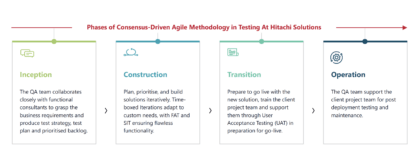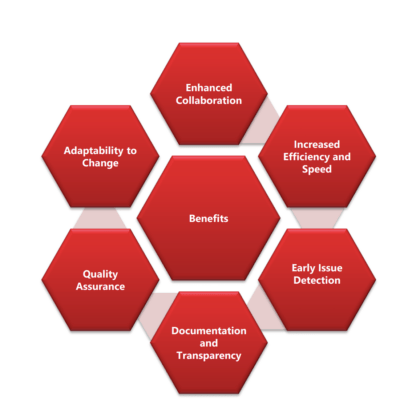
Agile Methodology for High-Quality Solutions Delivery
Agile Methodology
In the dynamic world of software development, Agile methodologies have revolutionised the way projects are delivered, emphasising flexibility, collaboration, and customer satisfaction. At the heart of this transformation, especially for organisations like Hitachi Solutions Europe, lies the core practice of Agile methodology in Testing, a critical component that ensures the delivery of high-quality solutions. Agile Testing diverges from traditional methods by integrating testing into the development process from day one, enabling continuous feedback and iterative improvement.
A Catalyst for Change
Agile methodology is a project management and software development approach that breaks projects into smaller, manageable pieces, allowing for more flexible and rapid responses to change. This iterative process involves cross-functional teams collaborating through all stages of project development, from planning and design to implementation and evaluation
Why Agile?
The need for Agile arises from the limitations of traditional software development methods, which often struggle to keep pace with the fast-changing requirements of the digital world. Agile methodology addresses these challenges by:
Enhancing adaptability to change
Product quality through continuous testing and feedback
Increasing stakeholder engagement and satisfaction
Accelerating time to market
Agile Methodology in Testing
At Hitachi Solutions Europe, Agile methodology is founded on a consensus-driven approach, emphasising teamwork, adaptability, and putting our clients at the forefront of every project. By adopting our consensus-oriented Agile approach, we ensure that testing is integrated from the outset, allowing for continuous feedback and adaptation to meet our clients’ changing needs.
We delve into key practices such as continuous integration, Test-Driven Development (TDD), and Behaviour-Driven Development (BDD), which facilitate early defect detection and resolution. Moreover, we highlight the importance of collaboration between developers, testers, and customers in building a shared understanding of requirements and outcomes.
The Phases of Consensus-Driven Agile Methodology in Testing
By focusing on these testing-specific activities within each phase, the QA team at Hitachi Solutions Europe ensures that quality is built into the product from the beginning and maintained throughout the lifecycle of the application.

Phase One: Inception Phase
- Define Objectives and Requirements: The QA team collaborates closely with stakeholders to understand the product and its requirements, setting the foundation for the test strategy.
- Testing Workshops: The QA lead conducts the test workshop with the Client to discuss the overall test approach with an emphasis on understanding the product from a quality perspective, identifying risk areas, and planning for testing activities.
- Develop Test Strategy: From the findings of the workshops, formulate a testing strategy that includes defining test objectives, scope, resource allocation, test environment setup, and test data requirements.
- Product Familiarisation for Testing: Engage with the product to develop an in-depth understanding that will inform test case creation and ensure comprehensive coverage.
Phase Two: Construction Phase
- Iteration Test Planning: For each iteration, plan the testing activities, including identifying which new features will be tested and which regression tests need to be run.
- Test Execution and Reporting: Conduct ongoing testing as features are developed, including unit tests, Functional Acceptance Test (FAT) and System Integration Test (SIT). Report issues and track bug resolution.
- Automation Script Development: Develop and refine automation scripts parallel to the development efforts to enable quick regression testing and efficient re-testing of bug fixes.
- Iteration Review from a Testing Standpoint: Review testing outcomes at the end of each iteration to assess coverage, defect trends, and areas needing attention in future iterations.
Phase Three: Transition Phase
- User Acceptance Testing (UAT) Planning and Execution: Facilitate and support UAT by preparing test scenarios, data, and scripts based on the agreed-upon acceptance criteria.
- Test Environment Stability: Ensure the test environment mirrors the production environment as closely as possible for accurate results.
- Training for Testing: Conduct training for key users on how to perform UAT effectively and how to report issues found.
Phase Four: Operation Phase
- Post-Deployment Testing: After the solution is live, perform post-deployment testing to ensure that the transition to the new system is smooth and that no critical issues have been missed.
- Ongoing Support and Maintenance Testing: As part of Lifetime Services, continue to provide testing support, including regression testing for new updates and patches.
- Test Suite Maintenance: Maintain and update test cases and automation scripts to reflect changes in the system and to ensure that the test suite remains relevant and effective for future development cycles.
By embracing a holistic, consensus-based testing approach within our Agile framework, we guarantee the provision of advanced, high-quality solutions that align with our commitment to excellence and ongoing improvement.
Seema Goswami
Senior QA Consultant at Hitachi Solutions
What are the Benefits of a Consensus-Based Agile Methodology in Testing?
Adopting a consensus-based Agile Testing approach brings a multitude of advantages that significantly uplift the quality and efficacy of software development initiatives. Key benefits include:

Embark on an Agile Journey at Hitachi Solutions
It’s evident that our consensus-based agile methodology in testing isn’t just a process; it’s a commitment to client success. By navigating through well-defined phases and embracing Agile principles, We ensure that every project is a journey towards excellence.
Connect with our experts to experience firsthand how Hitachi Solutions Europe is transforming Agile Testing into a strategic advantage.
